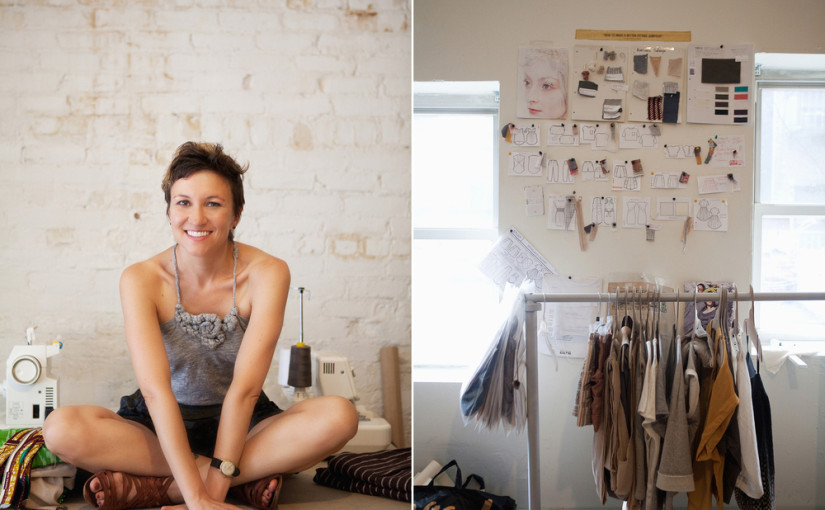I’ve begun to see a bit of the reason we have so much wrongdoing here on earth.
All too often, doing the right thing takes work.
Telling your Mother you accidentally knocked over her priceless antique vase is a far more daunting task than simply lying about it and walking away is easier than going to help that man who’s just dropped all his groceries in the middle of the street.
It terrifies me to think that coming generations will follow this paradigm. An age of apathy does not bode well for the future of, well, anything really. So how can we motivate the incoming class of humans to accept challenge as the necessary path?
By showing them the rewards, of course.
Enter Tara St. James. Founder and creative director behind Study NY, a Brooklyn-based ethical womenswear label. One glance at St. James’ sustainable production methods and the painstaking attention to detail is more than apparent. From zero waste cutting to ensuring that even the dye used on the fabric is environmentally responsible, Study NY is grabbing the fashion industry by it’s baubles. But it takes just one glance at the resulting collections to see the bountiful reaping of these efforts. A slow, conscientious design process leads to exquisitely crafted pieces made to conquer the test of time.
Tailoring cleaner than Danny Tanner’s home combined with captivating detail and strong lines. Who says aesthetic and sustainability have to be mutually exclusive?
Good luck finding that sort of craftsmanship at your local Target.
Garbage Pile: What first inspired you to create a sustainable label?
Tara St. James: When I first started recognizing the importance of sustainability in the fashion industry I was sourcing and producing collections in China and India. At the time organic cotton started making an appearance on the textile market and that prompted me to start researching the effects that pesticides, chemicals, water waste and cheap labour had on an industry I loved. I had first hand experience seeing the negative effects through my work with many mass market denim companies-one of the biggest polluters in the fashion world. Once I learned the information I couldn’t “unlearn” it and I haven’t looked back since.
GP: You’ve mentioned a love of mathematics in previous interviews. How does problem solving factor into your design process?
TSJ: Fashion IS problem solving. Finding the right fabric for a design, finding the right way to cut and sew that fabric, figuring out the least amount of waste when cutting a pattern, etc…perhaps most designers don’t see these problems as potential equations, but that’s just how my brain works.
GP: I hear designers speak constantly of the specific sort of woman their brand is intended for. Others say, however, that this practice limits the creative process, leaving no room for fluctuation of aesthetic. Where do you stand? Do you have a certain type of woman in mind when creating your pieces?
TSJ: I try not to limit my inspiration to a mythical woman who may or may not wear the pieces I feel compelled to create. Instead I ask myself whether I’d wear the style. Or my mom, she’s incredibly stylish and has always been a source of inspiration and a muse. If she’d wear it (and not just say she would because she loves me and wants to support me), then I know I’m on the right track.
GP: Study NY seems to truly realize the importance of long-lasting pieces. What are some staples in your own wardrobe?
TSJ: I have such a large collection of Breton stripes (like Coco and Jean Paul) I could wear a different piece every day for two weeks without repeating. And of course oversized jumpsuits, my collection of vintage and Study jumpsuits fill the other two weeks of the month!
GP: It seems to me that fast fashion companies such as H&M, Zara and Forever 21 have become something of an addiction. I often hear people speak as if the prices are too good to resist, though they may want to cut back on their shopping habits. Any advice for those in fast fashion rehab, so to speak?
TSJ: The customers in rehab are the lucky ones, they at least have the good fortune of having seen the dark side and want to rehabilitate. It’s the customers who are still addicted to fast fashion, or those who have no choice due to economic reasons, that I would really like to reach. My best advice for those who want to wane themselves off fast fashion is to try vintage where you can find incredible prices for really original – often one of a kind – items. And then to begin investing in well-made uniform pieces that you can wear forever. My rule of thumb is figuring out the cost-per-wear of each item you already own and then applying that theory to new purchases. Suddenly fast fashion doesn’t seem so cheap.
For more Garbage Pile goodness, find us on Instagram here









2 responses to “Sartorial Problem Solving and Fast Fashion Rehab: An Interview with Tara St. James of Study NY”
great post !
Thanks so much!!